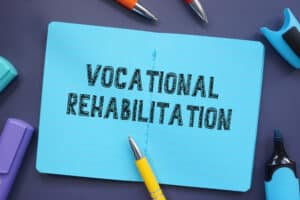
Vocational rehabilitation in workers’ compensation is a challenging and expensive area. Due to these factors, it is important that members of the claim management team understand the rights of the employee and responsibilities of the insurer in this area of benefits.
What is Vocational Rehabilitation?
Traditional workers’ compensation programs did not initially include vocational rehabilitation as a guaranteed benefit for people suffering from workplace injuries. In the 1960s and 70s, state legislatures started to add vocational rehabilitation as a right under workers’ compensation programs.
The main thrust of rehabilitation is to return the injured employee to their pre-injury position or another position where they have a similar economic status. While the roles of rehabilitation vary from state to state, the main areas of concern include coordination with the date of injury employer regarding return to work, job placement, on-the-job training and retraining.
Click Link to Access Free PDF Download
“13 Research Studies to Prove Value of Return-to-Work Program & Gain Stakeholder Buy-In”
How Does It Work?
An injured worker is typically eligible to receive rehabilitation services if they have a disability that prevents them from returning to work. In most jurisdictions, eligibility entitles them the ability to work with a specialized professional who has experience in assisting persons to coordinate medical and employment services. This person is often referred to as a “Qualified Rehabilitation Consultant,” or QRC.
The role of a QRC varies from state to state and is often defined by statute or rule. This person will usually have specialized training in helping persons with disabilities become gainfully employed. Their ability to “advocate” for the injured party is often limited, but they can provide expert testimony regarding economic forces and how that limits an injured worker in fully returning to the labor market.
The rehabilitation process often begins with an initial evaluation. This will include an interview with the injured worker and an assessment of their vocational and educational history, along with medical status. A report is then issued outline the barriers and opportunities for the impacted person. In some instances, a proposed plan is prepared that includes employment or further educational opportunities.
Return-to-Work or Retraining
In most instances, the initial steps of returning an injured worker to gainful employment is a focus on return to work. This can include opportunities in a light duty capacity with the date of injury employer, or job search in the local community. Other steps that can be taken include assistance obtaining employment through courses on how to prepare a resume and tips for successful interviews. A focus is also given on disability related issues.
Retraining is one of the main cost drivers in vocational rehabilitation. In some instances, this can include obtaining a high school diploma, GED certificate or a post-secondary education. Included in these costs often go beyond tuition, books and other school supplies. In most jurisdictions, insurance carriers are also required to pay the person wage loss benefits beyond any applicable statutory limits.
Practice Pointers When Confronting Rehabilitation
- Communication and cooperation. Studies indicate that most disabled persons want to re-enter the labor market. In order to be successful, claim management teams need to have open lines of communication beyond the injured worker. Including the date of injury employer is essential.
- Injured workers suffering severe injuries are faced with many challenges. While they may be receiving a wage loss benefit, these benefits are often paying a reduced wage. While receiving TTD or TPD, the injured worker is still expected to pay 100% of their everyday bills. Going the extra mile often pays dividends in the end.
- Specialization of claim management services. Identifying claims with a significant rehabilitation exposure is only the first step in the claims process. An effective claim management team should work with dedicate claim handlers when dealing with these issues to be cost-effective.
FREE DOWNLOAD: “13 Research Studies to Prove Value of Return-to-Work Program & Gain Stakeholder Buy-In”

















